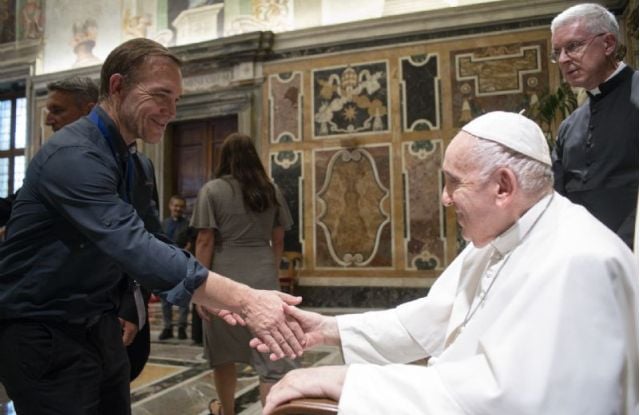Wolfgang Simpson wrote this – see if it doesn’t challenge you (8 more points coming in the next blog).
1 – Christianity is a way of life, not a series of religious meetings
Before they were called Christians, followers of Christ were called “The Way”. One of the reasons was that they had literally found the way to live. The nature of church is not reflected in a constant series of religious meetings led by professional clergy in holy places specially reserved to experience Jesus. Rather, it is the prophetic way followers of Christ live their everyday life in spiritual extended families, as a vivid answer to the questions that society asks, and in the place where it counts most – in their homes.
2 – Time to change the “cathegogue system”
The historic Orthodox and Catholic Church after Constantine in the fourth century developed and adopted a religious system based on two elements: a Christian version of the Old Testament temple – the cathedral – and a worship pattern styled after the Jewish synagogue. They thus adopted, as the foundational pattern for the times to follow, a blueprint for Christian meetings and worship which was neither expressly revealed nor ever endorsed by God in New Testament times: the “cathegogue”, linking the house- of-God mentality and the synagogue. Baptized with Greek pagan philosophy, separating the sacred from the secular, the cathegogue system developed into the Black Hole of Christianity, swallowing most of its society-transforming energies and inducing the church to become absorbed with itself for centuries to come. The Roman Catholic Church went on to canonize the system. Luther reformed the content of the gospel, but left the outer forms of ” church” remarkably untouched. The Free Churches freed the system from the State, the Baptists then baptized it, the Quakers dry-cleaned it, the Salvation Army put it in uniform, the Pentecostals anointed it and the Charismatics renewed it, but until today nobody has really changed the system. The time to do that has now arrived.
3 – The third Reformation
In rediscovering the gospel of salvation by faith and grace alone, Luther started to reform the church through a reformation of theology. In the eighteenth century, through movements in the pietistic renewal, there was a recovery of a new intimacy with God, which led to a reformation of spirituality, the Second Reformation. Now God is touching the wineskins themselves, initiating a Third Reformation, a reformation of structure.
4 – From church houses to house churches
From the time of the New Testament there has been no such thing as “a house of God”. At the cost of his life, Stephen reminded us: God does not live in temples made by human hands. The church is the people of God. The church, therefore, was and is at home where people are at home: in ordinary houses. There the people of God share their lives in the power of the Holy Spirit, have “meatings”, i.e. they eat when they meet; they often do not even hesitate to sell private property and share material and spiritual blessings; they teach each other in real-life situations how to obey God”s word – and not with professorial lectures but dynamically, with dialogue and questions and answers. There they pray and prophesy with each other, and baptize one another. There they can let their masks drop and confess their sins, regaining a new corporate identity through love, acceptance and forgiveness.
5 – The church has to become small in order to grow large
Most churches of today are simply too big to provide real fellowship. They have too often become “fellowships without fellowship”. The New Testament church was made up of small groups, typically between 10 and 15 people. It grew not by forming big congregations of 300 people to fill cathedrals and lose fellowship. Instead, it multiplied “sideways”, dividing like organic cells, once these groups reached around 15 to 20 people. This then made it possible for all the Christians to get together into city-wide celebrations, as in Solomon”s Temple court in Jerusalem. The traditional congregational church as we know it is, by comparison, a sad compromise: neither big nor beautiful, an overgrown house church and an undergrown celebration, often missing the dynamics of both.
6 – No church is led by a pastor alone
The local church is not led by a pastor, but fathered by an elder, a man of wisdom and engaged with reality. The local house churches are then networked into a movement by the combination of elders and members of the so-called fivefold ministries (apostles, prophets, pastors, evangelists and teachers) circulating “from house to house”, like the circulation of the blood. Here there is a special foundational role to play for the apostolic and prophetic ministries (Eph. 2:20; 4:11:12). A pastor (shepherd) is an important member of the whole team, but he cannot fulfil more than a part of the whole task of “equipping the saints for the ministry”, and he has to be complemented synergistically by the other four ministries in order to function properly.
7 – The right pieces – fitted together in the wrong way
To do a jigsaw puzzle, we have to put the pieces together according to the original pattern, otherwise the final product, the whole picture, turns out wrong, and the individual pieces do not make any sense. In the Christian world we have all the right pieces, but we have fitted them together in the wrong way, because of fear, tradition, religious jealousy and a power-and-control mentality. Just as water is found in three forms – ice, water and steam – so too the five ministries mentioned in Ephesians 4:11, 12 – the apostles, prophets, pastors, teachers and evangelists – are found today, but not always in the right forms and in the right places. They are often frozen to ice in the rigid system of institutionalized Christianity; they sometimes exist as clear water; or they have vanished like steam into the thin air of free-flying ministries and “independent” churches, accountable to no one. Just as it is best to water flowers with the fluid version of water, these five equipping ministries will have to be transformed back into new – and at the same time age-old – forms, so that the whole spiritual organism can flourish and the individual “ministers” can find their proper role and place in the whole. That is one more reason why we need to return to the Maker”s original blueprint for the Church.




Is it that difficult? Is your thesis (a very thoughtful one at that) really that revolutionary? I think many of these ideas will begin to naturally appear above the surface in the months and years to come, Seth. We won’t hear about them. They won’t be on the radar. But God is liberating, beautifying, equipping and commissioning a new order of disciples. Nothing will stop Him. He’s good at this stuff and He knows it. He’s got this problem…He thinks He’s God!
I’ve been travelling around the southern United States for the last three months saying all these things. I’m not at all surprised to see it here! I had this idea…
…what if those huge mega churches with 30,000 people broke off into their prized cell groups, and those cell groups became ‘church’. And the pastoral staff would travel around and hit 15 ‘churches’ in a week as a guest speaker. And a smaller version of the worship team would travel around and guest lead some worship. And then once every couple months, you’d rent out the stadium in the city, and have a huge celebration/worship service with everybody.
The ownership of the church transfers from the people getting paid to the congregants for once, because you can’t be annonymous in a 15 person ‘church’. And you also can’t Google a 15 person church, so we’d have to live our lives louder, talk about our faith, and actually invite people to church with us. And when your ‘church’ hits 20 people, you split into two groups of 10, no questions asked, no hard feelings.
Anyway…like I said…it was just this idea I had.
Love reading your blogs Seth
Thanks
Kristen
Finally got round to reading this, all I can say is BEAUTIFUL.Truly poetry to my ears 🙂